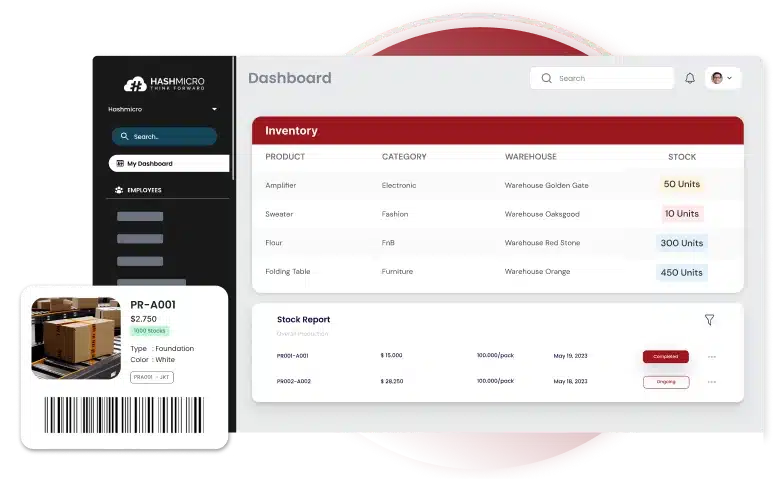Have you ever looked at your inventory and wondered how much of it is just sitting there, not being used? How much of it is costing you money every day? This is a common problem many businesses face, and it often goes unnoticed until it’s too late. But what if there was a way to manage your stock efficiently, reducing waste and saving money in the process?
This is where lean inventory management steps in. It’s a simple yet effective strategy that helps businesses reduce waste, improve efficiency, and cut costs. In this article, we’ll break down what lean inventory really is and how you can implement it in your business for maximum benefit.
What is Lean Inventory Management?
Lean inventory management is a system designed to minimize waste and reduce inefficiencies in stock management. At its core, the concept is simple: only keep the necessary inventory, not excessive and not short. By integrating inventory aging analysis, businesses can identify slow-moving items, thus effectively avoiding overstocking costs, such as storage costs, outdated products, and wasted resources.
However, this approach goes beyond simply reducing stock levels. When enhanced with inventory aging insights, lean inventory management optimizes operations to ensure products are available when needed, improving customer satisfaction and minimizing delays. This methodology is particularly important in industries such as manufacturing, retail and healthcare, where it helps prevent costly inventory issues and reduces the risk of dead stock, thus freeing up valuable capital and storage space.
In short, lean inventory management is about striking a balance in order to achieve optimal inventory levels. By utilizing inventory aging data, businesses can adopt cost-effective and agile strategies that allow them to remain responsive to changing customer demands.
5 Key Principles of Lean Inventory Management
Lean inventory is based on five core principles. These principles guide businesses in creating a system that eliminates waste and maximizes value for customers. Let’s take a look at these principles and how they help businesses run more efficiently.
1. Value
Understanding customer value is the foundation of lean inventory practices. Businesses must focus on delivering what customers actually want. By doing this, you can eliminate products or processes that don’t add value to the customer. The idea is simple: focus on what matters and cut out the rest.
For example, if customers value fast shipping, a lean inventory system ensures that popular items are always in stock and ready to go. This reduces the need for backorders and long waiting times, keeping customers happy and reducing waste.
2. Value Stream
Mapping the value stream means analyzing the entire process from start to finish—everything from raw materials to the finished product in the customer’s hands. This helps identify any steps that aren’t necessary and can be removed.
By clearly understanding the value stream, businesses can streamline operations and remove inefficiencies. Think of it as fine-tuning an engine; you’re getting rid of the parts that slow things down, ensuring a smooth flow from start to finish.
3. Flow
Once the value stream is mapped, the next step is creating a smooth flow. This means ensuring that products move through each stage of production without delays. Any bottlenecks or interruptions in the process can lead to wasted time and resources, so eliminating these is crucial.
In a lean inventory system, flow is all about maintaining momentum. Products should move seamlessly from one step to the next, keeping everything running efficiently and on time.
4. Pull
Instead of pushing products through the system based on forecasts, the pull principle ensures that items are produced or ordered only when there is actual customer demand. This avoids overproduction and reduces excess inventory.
For example, if you’re running a retail business, a lean inventory strategy would have you order products as customers buy them, rather than filling your stockroom with items that may not sell.
5. Perfection
Continuous improvement is key to lean inventory management. Even after implementing the system, businesses should regularly review their processes and look for areas to improve. This could mean fine-tuning production schedules, adjusting supplier relationships, or finding new ways to reduce waste.
The goal is to keep improving, constantly moving closer to perfection. By regularly reviewing your system, you can make small changes that add up to big results over time.
7 Types of Waste in Lean Inventory
Waste is the enemy of efficiency. Lean inventory practices aim to identify and eliminate seven types of waste that commonly occur in businesses. These are areas where companies lose time, money, and resources without realizing it. Let’s break down these types of waste.
- Overproduction
Producing more than what is needed leads to excess stock, which may never sell. This not only ties up capital but also takes up valuable storage space. - Waiting
Delays in the production process lead to wasted time. Whether it’s waiting for materials to arrive or machines to be repaired, any downtime is costly. - Excess Inventory
Holding onto more inventory than necessary results in storage costs, the risk of items becoming obsolete, and tied-up cash flow that could be used elsewhere. - Transportation
Moving products unnecessarily adds no value to the customer and can result in extra costs. Efficient inventory systems minimize the transportation of goods between locations. - Overprocessing
Doing more work than necessary, such as adding extra steps in production that don’t improve the product, leads to wasted time and effort. - Defects
Faulty products that need to be repaired or replaced are a clear form of waste. By improving quality control, businesses can avoid the costs associated with defects. - Unused Talent
Failing to fully utilize employees’ skills and talents is another form of waste. By training staff and involving them in continuous improvement processes, businesses can get the most out of their workforce.
Now that we’ve identified the common types of waste, it’s clear that lean inventory helps eliminate these inefficiencies. But what specific benefits can businesses expect?
Read More: Top Construction Inventory Management Software
Benefits of Lean Inventory Management
Implementing a lean inventory system comes with a wide range of benefits that help businesses save money, improve efficiency, and stay competitive. Here are some of the key advantages:
- Cost Reduction
One of the main benefits of lean inventory is the reduction in expenses. By cutting down on excess inventory and eliminating waste, businesses save money on storage, production, and materials. This allows more capital to be used for growth and other business opportunities. - Faster Fulfillment Times
With a lean inventory system, businesses can respond to customer orders more quickly. By keeping only what’s needed on hand, companies can reduce delays and ship products faster, improving customer satisfaction. - Increased Stock Turnover
Since lean stock levels are kept low, businesses can quickly sell and replenish items, ensuring that products don’t sit on shelves for too long. This not only keeps inventory fresh but also reduces the risk of items becoming outdated. - Environmentally Friendly
By minimizing waste, lean inventory practices contribute to a more eco-friendly and sustainable business model. Reducing overproduction, unnecessary transportation, and excess inventory all lead to a smaller environmental footprint.
With these benefits in mind, how can businesses implement lean inventory management effectively?
How to Implement Lean Inventory in Your Business
Bringing lean inventory management into your business doesn’t have to be difficult. Here are some actionable steps to get started.
- Build Strong Supplier Relationships
A successful inventory strategy relies on strong partnerships with suppliers. By working closely with suppliers, businesses can receive materials just in time, reducing the need to hold excess stock. This ensures that the supply chain is responsive and efficient, supporting your lean goals. - Use Inventory Management Software
Utilizing inventory management software makes implementing lean practices much easier. These tools allow you to track stock levels in real-time, automate reordering, and accurately forecast demand. Incorporating techniques such as FEFO ensures that older stock is used first, reducing waste and spoilage. This approach helps maintain just the right amount of inventory without overproducing or running out.
Once you’ve started implementing lean inventory, investing in cloud inventory software can greatly enhance your efficiency. Ready to take your inventory management to the next level? Click the banner below to explore HashMicro’s flexible pricing schemes and get started with the best inventory management control for your business!
Lean Inventory Management Strategies
Here are some specific strategies that help businesses succeed with lean inventory.
- Just-in-Time (JIT) Inventory
This strategy involves producing or ordering goods only when needed, based on actual customer demand. JIT ensures that businesses don’t overproduce or overstock, saving money and space. - Demand Forecasting
Accurately predicting customer demand is crucial to maintaining lean inventory levels. By analyzing sales data and market trends, businesses can adjust their stock levels to match expected demand, avoiding overproduction. - Inventory Optimization
Balancing inventory levels to meet customer needs while minimizing waste is essential to lean inventory management. This requires businesses to regularly review and adjust their inventory levels, ensuring they have just enough to meet demand. - Continuous Improvement
Lean inventory is not a one-time fix; it requires ongoing improvement. Businesses should regularly review their processes and look for ways to optimize their systems further.
While these strategies are effective, it’s important to understand the challenges that may arise when implementing lean inventory.
Challenges of Lean Inventory Management
Like any business strategy, lean inventory management comes with its own set of challenges. However, with the right approach, these challenges can be overcome.
- Resistance to Change
Employees may be hesitant to adopt new systems, especially if they’re used to more traditional inventory practices. Proper training and clear communication can help ease the transition to a lean system. - Lack of Data
It relies heavily on accurate data. Without reliable information on stock levels, sales trends, and demand, businesses may struggle to implement lean strategies effectively. - Technology Gaps
Outdated or inadequate technology can hinder the success of a lean system. Investing in the right tools, such as HashMicro’s inventory system, can help businesses overcome these challenges by providing real-time data and automation.
Despite these challenges, businesses that successfully implement lean inventory management see significant benefits. The right tools can make all the difference. Using manufacturing inventory software can further streamline operations and support lean practices.
How HashMicro’s Software Can Simplify Lean Inventory Management
Managing inventory manually often leads to inefficiencies, excess stock, and wasted resources. HashMicro’s Inventory Software helps you implement lean inventory practices, reducing waste and optimizing your operations:
- Automated Stock Tracking: Eliminate manual inventory counts. HashMicro’s software tracks your stock in real time, automatically adjusting for every sale, return, or purchase. This prevents overstocking and stockouts, keeping your system lean and efficient.
- Real-Time Data Updates: Forget outdated spreadsheets. With HashMicro, inventory data is instantly updated across your system, allowing you to make quick, informed decisions and adapt to changes in demand.
- Multi-Location Management: Whether you manage stock in one or multiple locations, HashMicro provides a unified view of your inventory control across all sites. This helps you optimize stock levels and streamline operations in line with lean principles.
- Smart Reordering System: Automate reorder points to maintain the right stock levels, preventing excess inventory or shortages and supporting lean inventory management.
- Custom Reports and Analytics: Get valuable insights into your inventory performance with customized reports, helping you continuously refine your lean strategy and reduce waste.
Ready to streamline your inventory and reduce waste? Try HashMicro’s Inventory Software with a free demo and see how it can transform your operations!
Conclusion
Lean inventory management is a powerful tool for businesses looking to cut costs, reduce waste, and streamline operations. By focusing on customer value, optimizing inventory processes, and leveraging technology like HashMicro’s Inventory Management Software, you can transform your business and stay competitive in today’s fast-paced market.
Ready to see its benefits for your business? Try HashMicro’s Inventory Management Software with a free demo and discover how you can optimize your operations, reduce waste, and boost efficiency today!

Frequently Asked Questions
-
What is inventory in lean waste?
Inventory in lean waste refers to holding more stock than necessary, which ties up capital, increases storage costs, and risks product obsolescence. It is one of the seven wastes lean management aims to reduce.
-
Why is lean inventory management important?
Lean inventory management minimizes excess stock, reduces waste, and improves efficiency. It helps businesses lower costs, respond quickly to demand changes, and streamline operations for better profitability.
-
What are the 5 rules of lean?
The 5 rules of lean are:
1. Define value from the customer’s perspective.
2. Map the value stream.
3. Ensure continuous flow.
4. Implement a pull system.
5. Pursue perfection through continuous improvement.


























